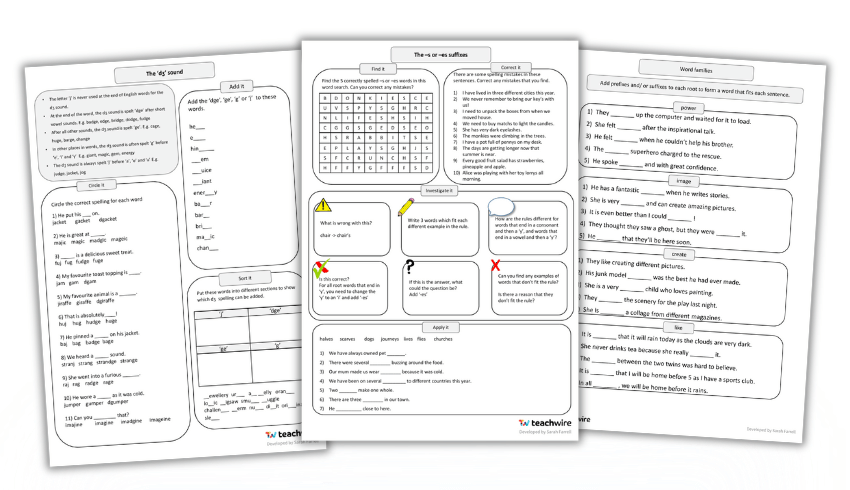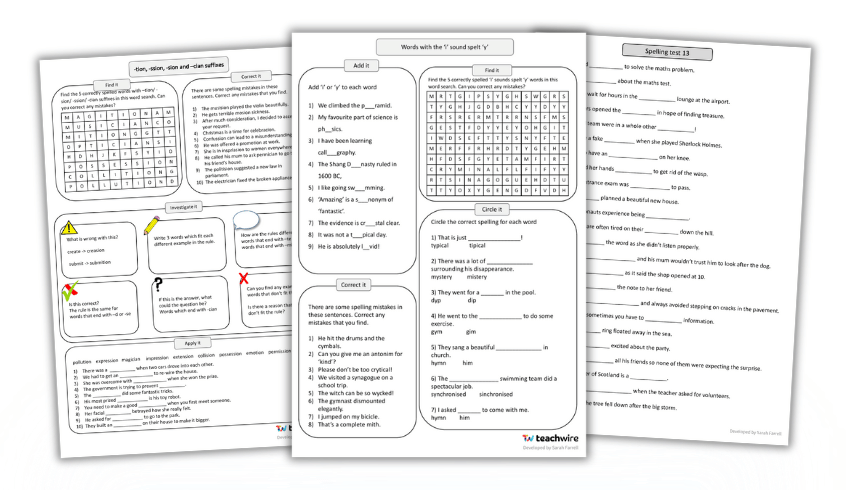Explore suffixes and prefixes with KS2 using this extensive pack of ready-made spelling games KS2 sheets. The download includes:
- A huge number of activities, including for prefixes, suffixes, spelling patterns for sounds, homophones and near-homophones, and ‘spot the spelling mistakes’ games
- 14 spelling tests
- Spelling rule explanations
- Answer sheets

The sheets cover prefixes including:
- im-
- in-
- ir-
- il
- and more
Suffixes covered include:
- -s
- -es
- -ing
- -ed
- -le
- -el
- -al
- -ly
- and more
The worksheets also cover varying spellings for sounds such as:
- ‘ay‘
- ‘ough’
- ‘ee‘
They also include an explanation of ‘there, their and they’re‘, along with games and activities to practise their usage.

This resource is definitely not a quick fix for spelling and should be used alongside good teaching that refers to phonics and etymology.
What is does do, though, is allow children to explore the different rules or generalisations that they’ll encounter in the English language.
Teaching spelling in KS2
Teaching spelling can be a bit of a minefield. There are so many different approaches, all with different advantages.
As English takes so many words from other languages (one statistic suggests this accounts for around 80 per cent of our collective vocabulary), we end up with many exceptions to the spelling ‘rules’.
Many people disagree with referring to them as rules for this reason, so perhaps ‘generalisations’ would be a better term, as it sounds less absolute.
Phonics knowledge
Having good phonics knowledge plays a huge part in learning to spell: if children can identify the different sounds they can hear, then they can make a phonetically plausible spelling suggestion.
There are many excellent resources out there that suggest ways to bring a more phonetic approach into the KS2 curriculum. Exploring the different rules or generalisations alongside solid phonics-based teaching helps children tackle unfamiliar words.
These spelling sheets give pupils the chance to explore and experiment with different spelling patterns.
A spelling guide
This resource contains a guide for using the spelling pattern you’re teaching – using a prefix to negate the root word, for example.
For example, it lays out that, for words starting with ‘m’ or ‘p’, we usually use the im- prefix (e.g. possible / impossible), rather than in- (impossible). There are exceptions, however – it’s not a hard and fast rule.
Having this guide available when children are completing the activities means they can refer back to it, rather than having to try to commit it to memory while it is still be explored. This also offers a level of scaffolding; more confident children may choose not to use it.
Root words
In this section, we’ve provided a set of words to which pupils can apply the spelling rule you’re working on.
E.g., for the -ing suffix, there’s a set of root words such as hope, cry, hint and mop to which they will add -ing (potentially involving adding or removing letters from the end of the word).
Fill in the gaps
Here, there’s a sentence containing a missing word, and several possible spellings to choose from. The spelling alternatives include likely misconceptions, and all refer back to the guide at the top.
How is he _________?
copping copeing coping
With this example, children will have to identify the root word (cope) and then apply the correct rule (in this case, remove the ‘e’ before adding the suffix).
Word categories
In this activity, give the class a set of words to sort into the correct groups. For example, give them patient, legible and regular and ask them to match each of these to the correct prefix from the list supplied (im-, in-, il-, ir-).
KS2 wordsearch
In general, I don’t think a wordsearch is necessarily a useful tool for spelling. However, these wordsearches contain five correctly spelled words as well as some incorrectly spelled ones.
There’s no list of words for pupils to find, so they must look for words and decide (with or without the guide’s help) whether they are spelled correctly or not.
Spelling mistakes
There is a set of sentences containing spelling mistakes, which children must correct. Not every word is wrong. Otherwise pupils quickly learn to just swap it for an alternative, rather than referring back to their prior knowledge (or the guide!) and judging the spelling for themselves.
Investigation skills
This is my personal favourite section, as it gives children a chance to discuss and really explore the rule through a few different lenses:
What’s wrong with this?
Provide a sentence containing a spelling mistake (He is gazeing at the stars) or an incorrect statement (You always double the last consonant before adding -ing).
Ask children to decide whether the statement is true or false, and explain why. In this example, they might say the statement is incorrect as the consonant is only doubled when the root word ends in a single vowel then a single consonant.
Write three words that fit each different category
Either using vocabulary they have already explored or using their own knowledge, ask children to find words to fit different categories, such as ‘Words with the prefix im-’.
Explain your reasoning
Give pupils a question or statement to discuss, such as ‘How are the rules different for words that end in ‘e’ and words that don’t end in ‘e’?’
Is this correct?
Provide a sentence containing the focus spelling (Unfortunately, he will be late for school), or a statement about the rule (To make any adjective an adverb, just add -ly) which pupils must prove or disprove.
Like with the ‘What’s wrong with this?’ challenge, the statements refer back to the guide at the beginning of the resource.
If this is the answer, what is the question?
As the name suggests, the idea here is to give pupils an answer for which they must find a possible question.
For example, for the in-, il-, im- and ir- prefixes, the answer may be ‘To change the meaning of the word to its opposite’, and children may suggest the question ‘Why is the in- prefix added to words?’
Finding exceptions
This is another of my favourite challenges, as it actively encourages children to look for exceptions or words that don’t fit with the others.
This then opens up discussion about why it doesn’t fit. Encourage children to suggest words that are exceptions to the rules they’ve learned (like the infamous ‘I before E except after C’!).
Some rules may not have any exceptions, but plurals often do, such as the plural of ‘fish’ not being ‘fishes’.
Choose the right word
In spelling lessons, we often give children a set of words and ask them to write a sentence for each one.
This can be quite difficult, as even if they know the meaning or find it in a dictionary, it can be tricky to put some words in context without direct instruction on how to do so.
Instead, try giving pupils a range of words related to the spelling pattern they’ve been studying, and get them to select the correct one to fit into different sentences, based on the context.
E.g: trying climbing hoping
He is ___________ a ladder.
Sarah Farrell is a KS2 teacher in Bristol who makes and shares resources online. Follow Sarah on Twitter @SarahFarrellKS2 and see more of her work at mrsfclassroom.wordpress.com. Browse our Year 3 and 4 spelling list resources, Year 5 and 6 spelling list resources and more SPaG games. Read advice for teaching SPaG consistently throughout your school.














